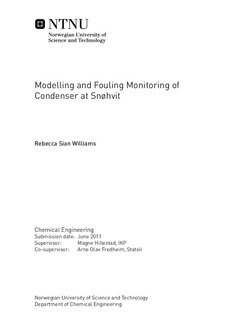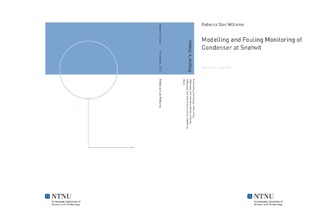| dc.description.abstract | This report is a result of the work performed during the Master Thesis TKP 4900 at the Department of Chemical Engineering, NTNU in the spring of 2011. The problem assigned was "Modelling and fouling monitoring of a condenser at Snøhvit". The work was done in collaboration with Statoil ASA on a Helixchanger condenser at the LNG plant at Melkøya outside of Hammerfest, Norway. The condenser, 25-HA-112, condenses a mixture of propane and ethane by heat exchanging against sea water.
A model describing the condenser 25-HA-112, based on the film method, was built in MATLAB. The model consisted of three sections; a cooling section, a section for integral condensation and a section for differential condensation. The differential model equations describing these were approximated by a collocation routine. The equation set consisted of both algebraic and differential equations and was solved using Newton's method. The thermodynamic model, based on Peng-Robinson equation of state, proved to be a challenge for the analysis. When changing the initial conditions for the condenser model, the thermodynamic model was unstable. This resulted in only small adjustments for each iteration could be made.
A second model, constructed in the simulation software Unisim, was used to validate the MATLAB model. The results from the two models seemed to coincide, strengthening the condenser model constructed in MATLAB.
A sensitivity analysis was carried out on the model using five parameters; vapour heat transfer coefficient, fouling resistance, vapour mass flow, sea water temperature and initial vapour composition. The results obtained in the sensitivity analysis performed as expected from theory, supporting the MATLAB model.
Experimental data obtained for 25-HA-112 at Melkøya were compared to a case model built in MATLAB. The results show that the MATLAB model does not predict a satisfactory result for the cooling and integral section of the condenser. Reasons for this deviation are discussed. The main causes are thought to be the use of a too coarse model, the assumption of a binary component model and a higher heat transfer coefficient in the real condenser due to turbulence. | |

